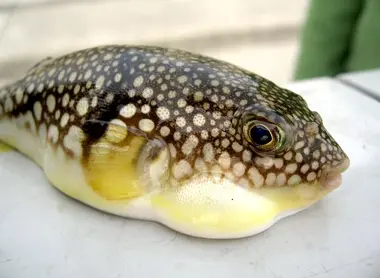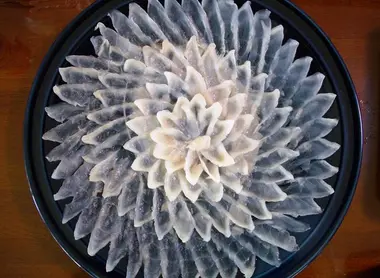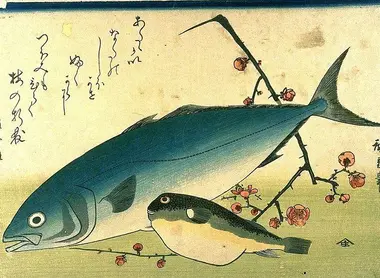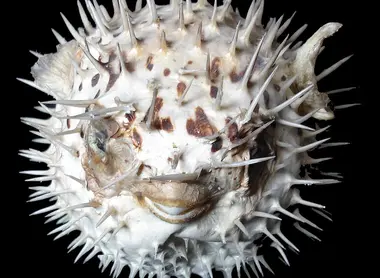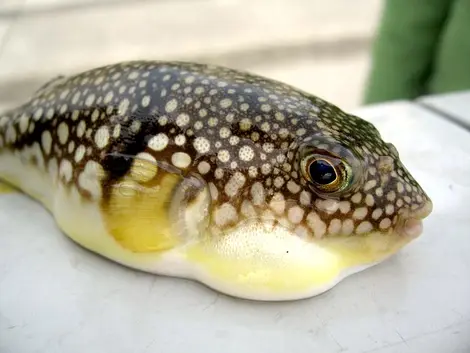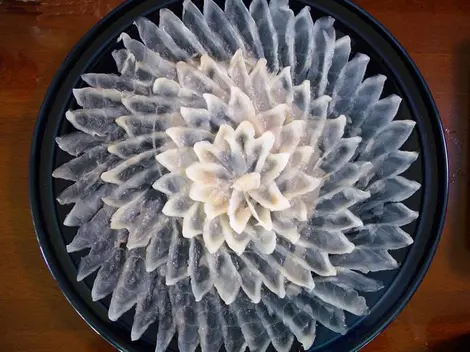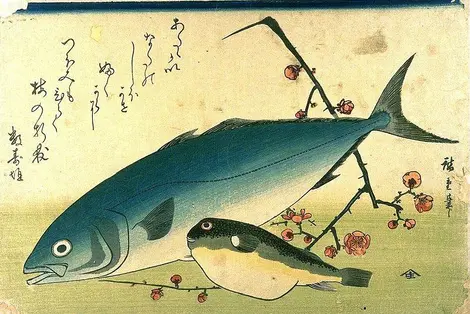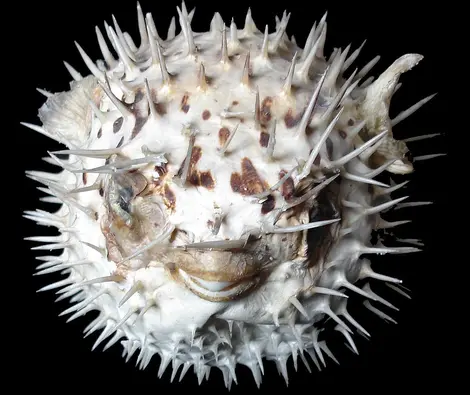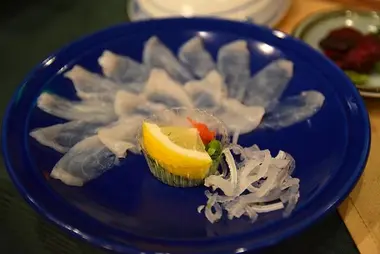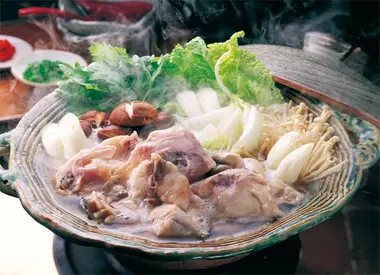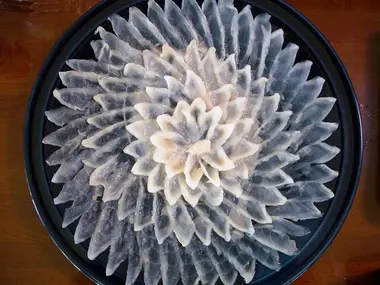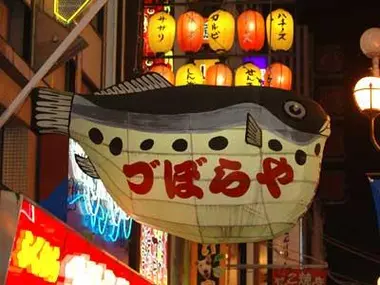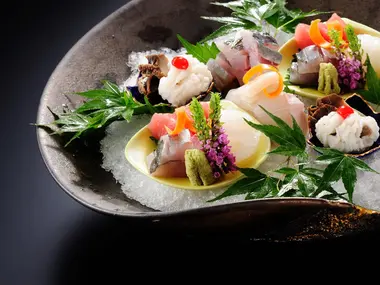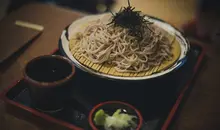Fugu: Delicacies and Dangers of the Japanese Pufferfish
- Published on : 06/11/2019
- by : G.L.
- Youtube
"Puffer fish", "sunfish", but what is this fish?
Fugu, the emblematic fish of Japanese gastronomy, fascinates as much as it worries with its duality. Known as puffer fish or balloon fish, it is renowned for its delicate flesh, but also for the deadly poison it contains. Every year, this exceptional delicacy attracts thousands of connoisseurs ready to pay large sums of money to enjoy this unique culinary experience. The tetrodotoxin it contains, more potent than cyanide, requires meticulous preparation by specially trained chefs. Between ancestral tradition and calculated risk, fugu perfectly represents that part of Japanese culture where culinary art rubs shoulders with danger.
What is fugu? Biology and characteristics of the pufferfish
The term "fugu" (河豚/鰒/鮐/魨/鯸/鯺) actually refers to several species of fish in the Tetraodontidae family. There are over a hundred different species, divided into seven main genera: Arothron, Canthigaster, Carinotetraodon, Lagocephalus, Sphoeroides, Tetraodon and Torquigene. Takifugu rubripes, or "torafugu", is considered the tastiest and most prized in Japan.
These fish have special anatomical features. They have four fused teeth forming a sort of beak (hence the name "tetra-odon" meaning "four teeth"). Unlike most fish, they have a face with two eyes positioned frontally, rather than laterally. The largest species can reach up to 90 cm in length.
The fugu's best-known characteristic is its ability to inflate with water in dangerous situations, tripling in volume in a matter of seconds. This spectacular metamorphosis enables it to repel predators by presenting a silhouette that is difficult to swallow and by bristling with spines. This defense complements its natural toxicity.
These fish are found in tropical and temperate waters of the three great ocean basins. Their life cycle begins with the laying of numerous eggs in shallow waters. The larvae remain close to the coast until they reach a sufficient size to migrate to deeper waters. Sexual maturity is reached between one and two years, when they return to coastal areas to reproduce.
Tetrodotoxin: understanding fugu's deadly poison
Fugu's fearsome reputation stems from tetrodotoxin (TTX), an extremely powerful neurotoxin found mainly in the fish's liver, ovaries, intestines and skin. This toxin is characterized by its chemical formula C11H17N3O8 and acts in minute, nanomolar concentrations.
Contrary to popular belief, this toxin is not produced by the fish itself. Research has shown that it comes from marine bacteria belonging to the Vibrio, Pseudomonas, Bacillus and Alteromonas genera, which the fugu accumulates in some of its organs. This explains why farmed fugu are generally less toxic or even non-toxic, as their controlled feeding limits their exposure to these bacteria.
Tetrodotoxin's mechanism of action is particularly formidable: it blocks voltage-dependent sodium channels in nerve cells, preventing the transmission of nerve signals. This causes progressive paralysis of muscles, including respiratory muscles, and can lead to death. The lethal dose is estimated at around 2 mg for a 50 kg adult, making it one of the most toxic substances known, 2,500 times more potent than procaine.
The effects of tetrodotoxin intoxication appear rapidly, usually between twenty minutes and three hours after ingestion. Initial symptoms include tingling and numbness around the mouth, followed by nausea, vomiting and difficulty walking. As paralysis progresses, victims experience muscular paralysis, breathing difficulties and finally respiratory arrest, which can lead to death. Worryingly, thereis currently no antidote for this toxin. Only rapid respiratory assistance can keep the person alive until the body naturally eliminates the toxin.
The art of fugu preparation: techniques and chef certification
Preparing fugu requires exceptional expertise and rigorous training, backed by official certification. In Japan, strict legislation has governed the preparation and sale of this potentially lethal fish since 1958. Only chefs with a special license are authorized to prepare fugu for consumption.
The path to becoming a fugu chef is particularly demanding. Aspirants must undergo a minimum of three years' training, rising to five depending on the region. This training generally takes place under the tutelage of an already-certified master. In Tokyo, a two-year apprenticeship is required before taking the exam, while in Yamaguchi prefecture, considered the strictest, a minimum of three years is required.
The final exam to obtain the license is extremely difficult, with a historically high failure rate. It includes a theoretical part testing knowledge of fugu anatomy and regulations, as well as a practical test where the candidate must perfectly prepare a fugu, removing all toxic parts without contaminating the flesh. Some exams even include a tasting of the fugu prepared by the candidate, demonstrating his or her absolute mastery.
The preparation technique is a precise art. The chef uses a special knife called a "fugu hiki", reserved exclusively for this purpose. The process begins by carefully eviscerating the fish while it is still alive, taking care not to pierce the liver or reproductive organs containing the poison. Removed toxic parts are stored in a special lockable garbage can to prevent any accidents.
Cutting fugu for sashimi requires exceptional precision. The slices must be so thin as to be almost transparent, often arranged in a chrysanthemum pattern on the plate. This finesse not only ensures an elegant presentation, but also an optimal taste experience, highlighting the unique texture of the flesh.
Restaurants serving fugu are subject to regular inspections by the health authorities to ensure that safety standards are met. Chefs must display their certificate prominently in the establishment, assuring customers that their meal has been prepared by a qualified professional.
Fugu in Japanese cuisine: flavours and tasting methods
Despite its reputation for being dangerous, fugu occupies a special place in Japanese gastronomy. Consumption in Japan amounts to some 10,000 tonnes a year, testifying to its enduring popularity. This sustained demand, combined with the skills required of chefs, makes it a particularly expensive delicacy, with prices rising to several hundred euros for a complete meal.
Fugu flesh has a unique texture, both firm and slightly elastic. Its taste is subtle, with some even finding it bland on first tasting. But it's the texture and culinary experience that make fugu so sought-after. Its nutritional value is interesting: rich in protein and low in fat, fugu also contains collagen, appreciated for its benefits to the skin.
Fugu can be enjoyed in a number of traditional ways:
- Fugu sashimi (tessa): Considered the most refined preparation, it consists of thin, transparent slices artistically arranged, often in the shape of a rosette. Enjoy with a tangy ponzu sauce, Japanese chives and grated daikon (white radish).
- Fugu nabe (chirinabe): This emblematic winter dish is a kind of pot-au-feu where pieces of fugu are cooked in a broth with vegetables, mushrooms and tofu.
- Fugu karaage: A fried version of fugu, where pieces of fish are coated in a light batter and fried to a crispy texture.
- Hirezake: This particular drink consists of hot sake in which a grilled fugu fin has been infused, imparting a unique smoky flavor.
A traditional fugu meal generally follows a precise progression. It begins with sashimi, followed by fugu nabe, then possibly fried fugu. The meal often concludes with zousui, rice cooked in the remaining broth of the nabe, concentrating all the flavors of the meal.
A particularity of fugu tasting is the slight numbness of the lips that some guests may experience. This is due to minute traces of tetrodotoxin still present in the edible flesh. This sensation, which is harmless in the doses consumed, is part of the experience sought by fugu lovers, creating the unique impression of having "grazed danger".
History and cultural significance of fugu in Japan
The history of fugu in Japan goes back several millennia. Archaeological findings have revealed fugu remains in shell middens dating back to the Jōmon period (14,000-300 BC), proving that this fish was already consumed in prehistoric Japan. Despite the obvious risks, its consumption has continued down the ages.
An important historical turning point came at the end of the 16th century, during the era of the warlord Hideyoshi. Soldiers in his army were seriously poisoned after eating fugu in Shimonoseki, leading to a ban on its consumption for almost two centuries. This prohibition was maintained during the Edo period (1603-1868), although some wealthy gourmets continued to consume it clandestinely.
The official "rehabilitation" of fugu is attributed to Prime Minister Hirobumi Ito (1841-1909 ) who, on a visit to Shimonoseki in 1888, tasted fugu and liked it so much that he lifted the ban. This anecdote, whether historically accurate or legendary, marks the beginning of the modern recognition of fugu as a culinary specialty.
In Japanese culture, fugu is much more than a simple dish. It symbolizes courage in the face of danger, the delicate balance between risk and pleasure. Consuming fugu was traditionally considered an act of bravery, particularly appreciated by the warrior classes such as the samurai. This dimension of defiance persists in the collective imagination, as witnessed by the tragic story of the famous kabuki actor Bandō Mitsugorō VIII, who died in 1975 after voluntarily consuming fugu liver to impress his guests.
Certain regions of Japan are particularly associated with fugu. Shimonoseki, in Yamaguchi prefecture, has proclaimed itself "Japan's fugu capital". The town is the main processing and distribution center, handling around 80% of the fugu caught or farmed in Japan. Every year on February 9, Shimonoseki holds a festival in honor of this emblematic fish.
The other region renowned for its fugu isOita prefecture, particularly around the spa town of Beppu and the city ofUsuki, on the island of Kyushu. Both regions have major fugu fishing ports and a large number of specialized restaurants.
Today, fugu is an integral part of Japanese luxury gastronomy and embodies Japanese culinary excellence. Its preparation is considered an art, and specialized chefs enjoy great prestige. Fugu is often reserved for special occasions and celebrations, representing a privileged moment in the Japanese gastronomic experience.
Fugu regulations and food safety
Faced with the risks inherent in eating fugu, Japan has put in place one of the strictest regulatory frameworks in the world. Since 1958, specific legislation has governed the preparation, sale and consumption of this fish, with the aim of drastically reducing cases of intoxication.
Central to these regulations is therequirement for chefs wishing to prepare and serve fuguto be certified. The certification process varies from prefecture to prefecture, but always includes extensive training and a rigorous examination. In Tokyo, for example, the pass rate for the exam has historically been under 35%, testifying to its exacting standards.
Japanese law strictly prohibits the sale of liver and other venomous parts of fugu for consumption. Professional fishermen and private individuals are also strongly discouraged from preparing their own fugu, as this practice has been identified as the main cause of fatal poisoning.
In approved restaurants, chefs must visibly display their certificate proving their competence to serve this dangerous fish. Establishments are also subject to regular inspections by health authorities to check compliance with safety procedures.
Thanks to these strict measures, the number of fugu-related incidents has fallen considerably in recent decades. According to data from the Tokyo Welfare and Public Health Bureau, between 1996 and 2006, Japan recorded between 20 and 44 incidents per year, causing between 34 and 64 hospitalizations and 0 to 6 deaths, giving a mortality rate of 6.8%. Between 2006 and 2009, 119 incidents were recorded, involving 183 people and 7 deaths.
It is noteworthy that most cases of poisoning do not come from certified restaurants, but from domestic preparation. Of the 23 incidents recorded in Tokyo between 1993 and 2006, only one involved a restaurant; all the others concerned fishermen eating their own catch.
Since 2012, ordinary restaurants in Japan have been able to offer fugu, provided that it has first been prepared and cleaned by a certified chef. This regulatory change has widened access to this delicacy while maintaining safety standards.
In the event of intoxication, medical treatment is essentially symptomatic, as there is no antidote for tetrodotoxin. Patients are hospitalized for close monitoring and, if necessary, placed on mechanical ventilation until the body naturally eliminates the toxin, which can take several days.
Fugu around the world: expansion and cultural representations
Although fugu is mainly associated with Japan, its consumption is spreading to other parts of the world, sometimes with different preparation traditions. In Polynesia, particularly in the Tuamotu archipelago, there is an ancestral tradition of fugu preparation handed down from generation to generation. In Taiwan, particularly in the Pescadores (Penghu) islands, fugu is also caught in large quantities and prepared using local techniques.
In recent decades, fugu has begun to colonize the eastern Mediterranean, particularly the coasts of Turkey and Greece. This phenomenon, linked to global warming and species migration, has already led to cases of intoxication in these regions, where traditional knowledge of the dangers of fugu is less widespread.
At the same time, there is a worrying over-exploitation of certain species. According to the International Union for Conservation of Nature, the global population of Takifugu chinensis has declined by 99.99% since the 1970s, illustrating the impact of growing demand on these vulnerable species.
In popular culture worldwide, fugu has acquired a special place, often associated with danger and Japanese exoticism. It frequently appears in films, TV series and literary works, usually to evoke the lethal risk it represents.
Among the best-known references is the Simpsons episode "A Fish Called Fugu", in which Homer believes he will die after eating poorly prepared fugu. In literature, works such as Colin Harrison's "The Havana Room" feature delirious auctions for fugu sushi. In the James Bond saga, tetrodotoxin appears as a potential weapon in "Best wishes from Russia".
These cultural representations help to maintain the mysterious and dangerous aura of fugu in the world's collective imagination, reinforcing its status as an exceptional delicacy that goes far beyond the strictly culinary.
For adventurous gourmets visiting Japan, several renowned establishments offer high-quality fugu tasting experiences. In Tokyo, the Michelin-starred Usukifugu Yamadaya restaurant offers an exceptional but expensive dining experience. In Osaka, the Zuboraya restaurant is also renowned for its fugu preparations.
For travelers wishing to explore this specialty in Tokyo, here are some recommended addresses: 8 fugu restaurants in Tokyo. For those who prefer a less risky Japanese culinary experience, other options exist such as For something simpler and less risky: Cooking at home or Learn to cook like the Japanese with one of our travel angels.
Fugu remains a powerful symbol of Japanese gastronomy, embodying culinary refinement, technical mastery and a fascination with the subtle balance between pleasure and danger that characterizes certain aspects of Japanese culture.
